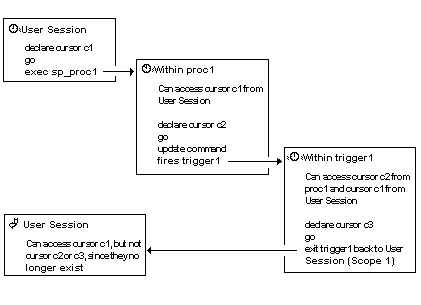A cursor’s existence depends on its scope. The scope refers to the context in which the cursor is used: within a user session, a stored procedure, or a trigger.
Within a user session, the cursor exists only until the user ends the session. The cursor does not exist for any additional sessions that other users start. After the user logs off, Adaptive Server deallocates the cursors created in that session.
If a declare cursor statement is part of a stored procedure or trigger, the cursor created within it applies to that scope and to the scope that launched the stored procedure or trigger. However, cursors declared inside a trigger on an inserted or a deleted table are not accessible to any nested stored procedures or triggers. Such cursors are accessible within the scope of that trigger. Once the stored procedure or trigger completes, Adaptive Server deallocates the cursors created within it.
Figure 17-3 illustrates how cursors operate between scopes.
Figure 18-3: How cursors operate within scopes

A cursor name must be unique within a given scope. Adaptive Server detects name conflicts within a particular scope only during runtime. A stored procedure or trigger can define two cursors with the same name if only one is executed. For example, the following stored procedure works because only one names_crsr cursor is defined in its scope:
create procedure proc2 @flag int
as
if @flag > 0
declare names_crsr cursor
for select au_fname from authors
else
declare names_crsr cursor
for select au_lname from authors
return